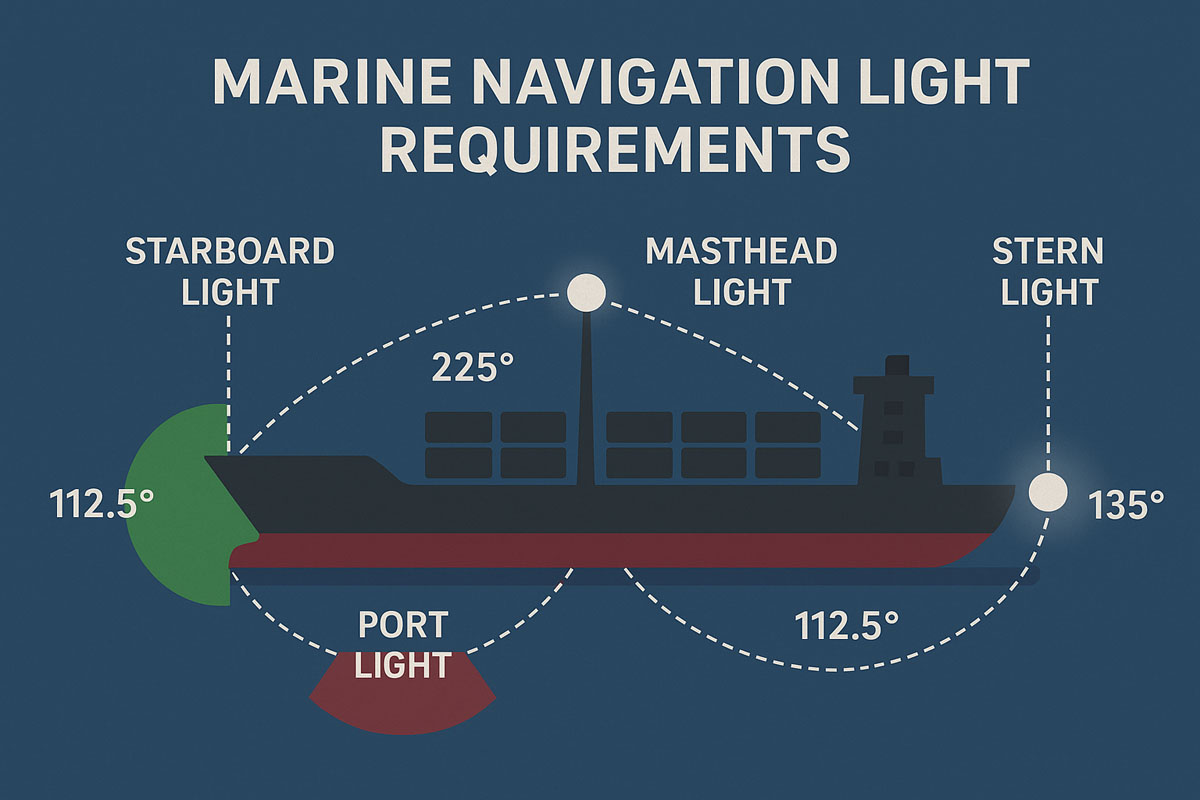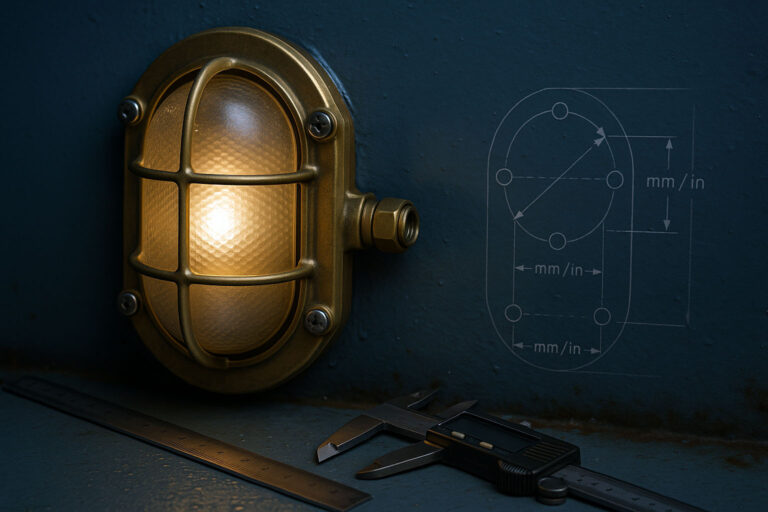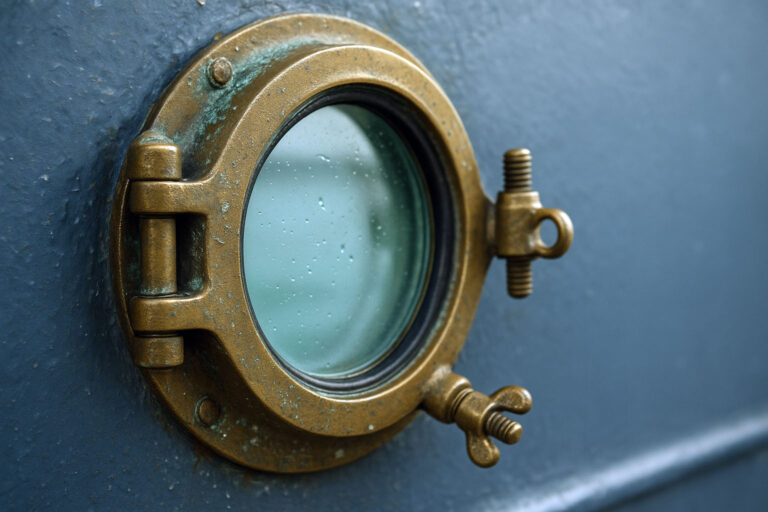Everything You Need on Marine Navigation Light Requirements for Cargo Ships
Marine navigation light requirements for cargo ships are critical for safe night‑time operations. They prevent collisions and ensure legal compliance under international rules. Plus, these lights align with COLREGs and SOLAS V, the backbone of vessel‑safety standards. By following them, we protect lives at sea and meet regulatory intent.
Overview of International Regulations (SOLAS & COLREGs)
The Convention on the Safety of Life at Sea (SOLAS) Chapter V covers safety of navigation. It mandates navigation‑light installations, maintenance, and use. However, the International Regulations for Preventing Collisions at Sea (COLREGs) Rules 23–31 detail light‑display rules. They apply to all power‑driven cargo ships ≥50 m LOA. Plus, flag states enforce these rules during inspections and port‑state controls.

Required Navigation Lights for Cargo Ships Underway
When a cargo ship is underway, it must show:
-
Masthead light(s)
-
Sidelights
-
Stern light
-
Towing light (if towing)
Each light serves a unique purpose. Next, we explore their specs.
Masthead Light(s)
As a cargo‑ship expert, I know masthead light requirements are strict. SOLAS V and COLREGs Rule 23 state a forward‑facing white light. For vessels ≥50 m LOA, you need two: one forward, one abaft the forecastle. Each has a 225° arc of visibility. Plus, they must be visible for at least 6 M in clear weather. This setup ensures other vessels see your ship’s heading and status.

Sidelights
Sidelights help show your ship’s port and starboard sides. The red port light shines from dead ahead to 112.5° abaft the beam. The green starboard light does the same on the other side. Each must be located near the bow and visible for at least 3 M. These specifications come from COLREGs Rule 23(a)(iii). They signal your ship’s orientation and avoid head‑on risks.

Stern Light
A white stern light completes the picture. It’s mounted as low as practicable at the stern. It has a 135° arc, centered on dead astern, and shines 3 M. For vessels <50 m LOA, this light replaces all‑around white lights. COLREGs Rule 23(a)(iv) covers these details. This light shows your vessel is moving away, helping others navigate safely.

Towing Light
Next, towing light requirements kick in when towing over 50 m total length. You mount an all‑around yellow light above the stern light. It shares the 135° arc and 3 M visibility. COLREGs Rule 24 – Towing and Pushing governs it. This yellow light tells nearby ships you’re towing, reducing collision risk with your tow.

Positioning, Arc of Visibility & Range Specifications
To meet visibility range and arc of visibility standards, you need precise mounting. Here’s a quick reference:
-
Masthead light: 6 M range; 225° arc; forward position; ≥1 m above sidelights.
-
Sidelights: 3 M range; 112.5° arc; near bow; height per flag‑state rules.
-
Stern light: 3 M range; 135° arc; stern mounting; height low as practicable.
-
Towing light: 3 M range; 135° arc; above stern light; yellow all‑around.
Plus, lateral positions must prevent overlapping arcs. These specs align with Performance Standards MSC.253(83).

Performance & Equipment Standards (MSC.253(83))
IMO MSC.253(83) sets performance standards for navigation lights. It covers luminous intensity, lamp controllers, and photometric tests. The rules entered into force on January 1, 2009. Flag states verify conformity during surveys. Plus, equipment must include backup circuits and correct beam‑cutting optics. These controllers ensure lights switch on under power failure and maintain steady output.

Conclusion
Marine navigation light requirements for cargo ships save lives and meet legal duties. By following COLREGs and SOLAS V, we ensure safe cargo operations. However, it’s not enough to install lights. Regular inspections and flag‑state certification checks are a must. Stay compliant and proactive. It keeps your crew and other vessels safe, always meeting compliance and inspection needs.
Frequently Asked Questions (FAQs):
What is the minimum visibility range for cargo‑ship navigation lights?
Masthead lights on cargo ships must be visible for at least 6 M in clear conditions. All other required lights—sidelights, stern lights and towing lights—need a minimum visibility of 3 M. This ensures other vessels can see your ship’s orientation and status at night.
When is a second masthead light required on a cargo vessel?
A second masthead light is mandatory when a cargo ship is 50 m or longer. It must be mounted abaft the first light, above the forecastle. This extra light improves visibility and helps other vessels judge the ship’s length and heading more accurately.
How do towing‑light requirements differ from stern‑light rules?
Towing lights must be all‑around yellow, mounted above the white stern light, and share the same 135° arc and 3 M range. Stern lights are white with a 135° arc and 3 M range. The yellow color and higher position distinguish towing operations from normal stern lighting.
What tests must lights pass under MSC.253(83)?
Under MSC.253(83), navigation lights undergo photometric tests for luminous intensity and beam distribution. They also face endurance checks for controller reliability and power‑failure response. These tests confirm each light meets IMO performance standards before entering service.
Are there exemptions for vessels under 50 m LOA?
Yes. Vessels shorter than 50 m LOA may use a single all‑around white light instead of separate masthead and stern lights. However, they still need port and starboard sidelights with standard arcs and ranges, and must follow towing‑light rules if towing over 50 m.







